Egyptian fishery production grew from 724,300 tons in 2000 to 1.3 million tons in 2010 (GAFRD, 2011) primarily due to growth in aquaculture production which increased its share of total production from 47 per cent in 2000 to 70 per cent in 2010 (GAFRD (General Authority for Fishery Resources Development), 2000:2011 and Macfadyen et al., 2012). Mapping of the fish seed value chain in early 2012 revealed that there has been a corresponding expansion of the tilapia hatchery sector. The Egyptian fish seed sector started in the 1980s when the government decided to establish 14 freshwater carp hatcheries (Nasr-Allah et al., 2012 and Saleh, 2007). These hatcheries also started spawning tilapia in earthen ponds using the methods described by Yater and Smith (1985) and Little and Hulata (2000). The first private tilapia hatchery started operation in 1992, increasing to seven by 1996 and reaching 135 licensed and an unknown number of unlicensed hatcheries by 2010 (GAFRD (General Authority for Fishery Resources Development), 2000:2011 and Radwan, 2008). Mapping by the Improving Employment and Incomes through Development of Egypt's Aquaculture Sector (IEIDEAS) project in 2012 suggested that there are around 440 tilapia hatcheries in Egypt (Nasr-Allah et al., 2012).
Most use hapa-based production systems in earthen ponds using the methods developed in South East Asia for commercial production of Nile tilapia fry and fingerlings (Bhujel et al., 2001, Bhujel et al., 2007, Escover et al., 1987, Little and Hulata, 2000 and Little et al., 1995). Hapas in ponds are cheap to construct and more convenient to manage in commercial tilapia hatcheries (Bhujel, 2000). A range of hapa sizes are used; in Egypt, they are typically 7 m × 3 m × 1 m whereas Bhujel et al. (2001) reported the use of larger nylon hapas (24 m × 5 m) suspended in fertilized ponds for tilapia spawning in Thailand.
One of the main challenges faced by Egyptian aquaculture is the seasonality of the climate. While summer temperatures are very suitable for growth and reproduction of the main farmed species, Nile tilapia, winter temperatures fall well below the optimal levels for growth and propagation (25–30 °C). Saleh (2007) stated that surface water temperatures in winter are between 19 and 20 °C on sunny days, and falling to 7–10 °C in colder weather. If fish are kept in shallow water they can suffer stress leading to high mortalities if low temperatures persist.
A recent modification of hapa-based systems has been to cover ponds with greenhouses to increase water temperatures and facilitate early spawning of tilapia (Saleh, 2007). Other hatchery operators have developed tank based spawning systems, also enclosed by greenhouses and often supplied with heated water from boilers or groundwater (Sadek, 2011). Using these systems, hatchery operators are able to meet the high demand for seed by fish farmers early in the season (Abou-Zied and Ali, 2007, Eldokla et al., 2011, Macfadyen et al., 2012, Naiel et al., 2011, Nasr-Allah et al., 2012, Radwan, 2008 and Saleh, 2007).
Only a limited number of studies have highlighted the technical characteristics and economic performance of different commercial tilapia hatchery systems in Egypt (Abou-Zied and Ali, 2007, Eldokla et al., 2011 and Naiel et al., 2011). None of them focused on critical factors facing operators of fish hatcheries.
This paper compares the economic and technical performance of three different types of tilapia hatcheries, identifies critical hatchery subsector problems and proposes recommended actions to address them.
The three different tilapia systems are as follows:
- hapas in outdoor ponds (hapa) (Fig. 1),
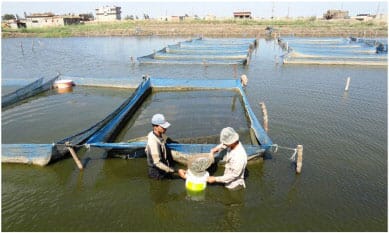
- hapas in ponds enclosed by a greenhouse tunnel (greenhouse) (Fig. 2), and
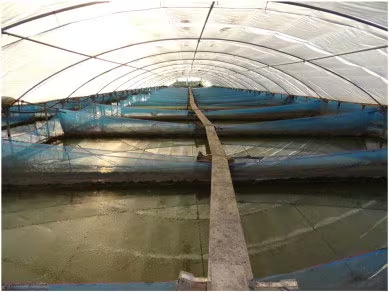
- tanks supplied by heated water (from a boiler or borehole) and enclosed by a greenhouse tunnel (heated greenhouse) (Fig. 3).
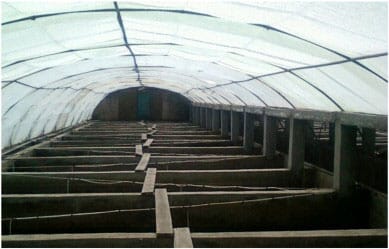
The analysis is designed to help Egyptian fish farmers to make informed decisions about which type of hatchery to operate. However, it is also relevant to fish farms in many other parts of the world where tilapia hatcheries face fluctuating temperature regimes, such as high altitude zones of tropical and sub-tropical Africa, and areas encountering the effects of climate change.
Results and discussion
Operational characteristics of tilapia hatcheries
All the hatchery operators interviewed specialize in producing all-male, Nile tilapia fry and fingerlings. In order to produce all-male tilapia, fry are fed immediately after yolk sac absorption on hormone (17α-methyltestosterone) treated feed for 3–4 weeks at a dose of 60 mg/kg feed (Saleh, 2007). All male tilapia are generally faster growing than females and the technique reduces or eliminates problems caused by early reproduction in ponds (Nasr-Allah et al., 2012). Egyptian tilapia hatcheries operate on a seasonal basis as temperatures are too low during winter months (November–February). The usual tilapia spawning cycle in Egypt starts with stocking of breeding systems with brood fish in February–April. Collection of fry starts two weeks after brood fish are stocked. Heated greenhouse hatcheries start stocking brooders and warming water in February, while hapa-based hatcheries start stocking brooders in April. The fry then undergo sex-reversal for 3–4 weeks before they are sold as all-male fry (0.2–0.5 g). It takes another 4–6 weeks before these fish can be sold as fingerlings (1–5 g) (Nasr-Allah et al., 2012 and Saleh, 2007).
As shown in Table 2, the average time that hatcheries had been in operation was 11 years, ranging from 9.9 years for the hapa based hatcheries to 11.9 years for greenhouse heated hatcheries. The average land area used for the hatcheries (1.72 ha) increased significantly with increasing levels of technical intervention (hapa, greenhouse, and heated greenhouse). Land tenure was a mixture of owned land and rented land (42 per cent and 58 per cent, respectively).
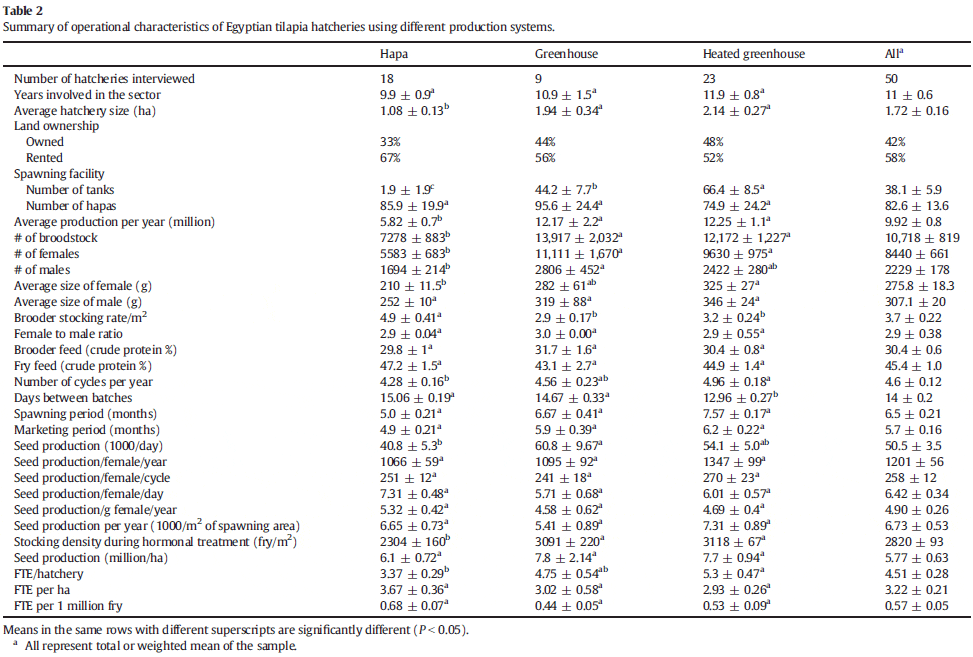
The average number of concrete tanks and hapas used in each hatchery system is summarized in Table 2. The usual dimensions of spawning tanks were 8 m long × 3 m wide × 1 m deep, while the usual hapa dimension was 7 m × 3 m × 1 m (Nasr-Allah et al., 2012). The average number of concrete tanks per hatchery was highest in heated greenhouse systems (66.4) followed by greenhouse only (44.2) and outdoor (hapa-based) hatcheries (1.9). The average number of hapas was 75 in heated greenhouse systems, 86 in outdoor hapa-based systems and 95.6 in greenhouse-based hatcheries. Operators of heated greenhouse hatcheries explained that they use hapas in addition to their enclosed tanks for spawning and early rearing during the summer to scale up production.
The average annual seed (fry and fingerling) production rate per hatchery was 9.92 million/year. It was significantly lower (P < 0.05) in hapa-based hatcheries (5.82 million/year) than in greenhouse hatcheries (12.17 million/year) or heated greenhouse hatcheries (12.25 million/year). These figures are higher than the average Egyptian hatchery production rates of 4.5 and 5.85 million per year as reported by Eldokla et al. (2011) and Naiel et al. (2011). Bhujel et al. (2001) reported that high numbers of broodstock are required in large scale tilapia hatcheries in Thailand to produce 5–10 million tilapia fry per month. The average total number of broodstock (male and female) held in hatcheries was highest in greenhouse systems (13,917) followed by heated greenhouse hatcheries (12,172) and outdoor hapa-based hatcheries (7261) but there was no significant difference between systems (P > 0.05). Naiel et al. (2011) reported an average of 4340 female broodstock per tilapia hatchery in 2009 compared to an average of 8440 per hatchery in this study. The relationship between seed output and number of females stocked in the three hatchery systems is shown in Fig. 5. Seed output numbers show a strong positive correlation (P < 0.01) with the number of female broodstock in each of the hatchery systems.
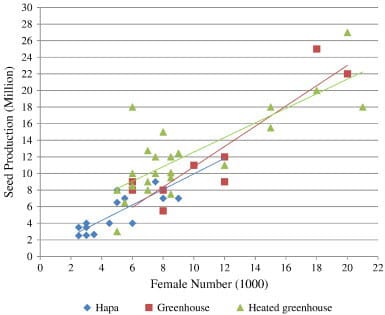
Hapa hatchery: Y = 1.087 + 0.880x (R2 = 0.800, P b 0.001).
Greenhouse hatchery: Y=-1.261 + 1.213x (R2 = 0.832, P b 0.01).
Heated greenhouse: Y= 3.934 + 0.874x (R2= 0.636, P b 0.001).
Extruded, floating fish feeds are now widely available in Egypt and are used in many hatcheries. The average protein level in broodstock feeds used by tilapia hatcheries in this study was 30.4 per cent (Table 2). A high level of dietary protein in feed for tilapia broodstock has been found to increase the number of eggs per spawn and reduce the spawning interval (Bhujel, 2000 and Little and Hulata, 2000). Bhujel et al. (2007) studied the relationship between feeding rate and seed output and reported that the optimal feeding rate was 2 per cent of fish weight/day. In this study, hatchery operators reported that they use a high protein (average 45.4 per cent CP) powder feed for feeding tilapia fry (Table 2). Most operators rely on commercial fry feed produced by local companies while some produce their own on-farm feed.
The average stocking rate for broodstock in outdoor, hapa-based hatcheries in this study was 4.9 fish per square meter of water surface, which was significantly higher than in greenhouse-based hatcheries (2.9 fish per square meter) and heated greenhouse systems (3.2 fish per square meter) (P < 0.05). The reported sex ratio of 3 females to 1 male was the same in all three systems. Bhujel (2000) reported that high broodstock stocking densities could have a negative effect on seed production, also concluding that biomass weight or the relative sizes of male and female fish are more important than the sex ratio. The female to male sex ratio reported in this study was lower than that reported by Yater and Smith (1985) and Escover et al. (1987).
Manipulation of the water temperature enabled significant increases in number of spawning cycles per year (P < 0.05). The number of days interval between fry collection batches was significantly (P < 0.05) shortened in heated greenhouse-based systems compared to hapa-based systems and greenhouse based-systems ( Table 2). Hatchery operators practice broodstock rotation and only stock mature females in the spawning units while resting spent females in hapas or tanks, separated from males.
The study showed that hatcheries with greater control over water temperatures were able to complete more spawning cycles per year and have shorter intervals between collections of spawning batches. Heated greenhouse hatcheries produced an average of 1347 fry per female per year compared to 1095 in greenhouse-based hatcheries and 1066 in outdoor, hapa-based hatcheries. Naiel et al. (2011) reported that fry production in Egyptian tilapia hatcheries was 1467 fry/female/year while Abou-Zied and Ali (2007) reported between 519 and 951 fry/female/year in their study on Fayoum tilapia hatcheries suggesting that variation was due to differing female weights, hatching and hatchery management systems. This study found that seed production per day varied significantly between systems (P < 0.05) with the highest in greenhouse systems followed by heated greenhouse and finally hapa-based systems (60.8, 54.1, and 40.8 thousand seed/day, respectively). The average seed production rate across all systems was 50.0 thousand seed/day.
The number of fry produced per female per cycle was not significantly different (P > 0.05) between the three hatchery systems. Similarly, seed production per unit weight of females was not significantly different between the three hatchery systems with an average of 4.9 fry/g of female weight per cycle. The average number of seed produced per female per day was 6.42 with no significant differences between hatchery systems.
Greenhouse and heated greenhouse hatcheries used significantly higher fry stocking rates during hormone treatment (P < 0.05). These ranged from 2304 fry/m2 in hapa-based hatcheries to 3118 fry/m2 in greenhouse and heating systems, with an average stocking rate of 2820 fry/m2. Increasing the level of control over water temperature was generally accompanied by increasing investment. The more sophisticated hatcheries also invested in water aeration equipment, allowing them to safely hold higher numbers of fry.
Table 2 includes the data collected on employment in Egyptian fish hatcheries. The average number of full-time equivalent (FTE) jobs was higher in more intensive hatcheries (3.37, 4.75 and 5.3 FTE/hatchery for hapa, greenhouse and heated greenhouse, respectively). The number of jobs per unit area appeared to be slightly higher in hapa-based systems (3.13 FTE/ha), followed by heated greenhouse (2.48 FTE/ha) and greenhouse systems (2.45 FTE/ha), however the differences were not statistically significant (P > 0.05). Nasr-Allah et al. (2012) reported that a high proportion (59 per cent) of hatchery employees were under 30 years old and that hatchery employees tend to be classed as skilled staff receiving higher wages than ordinary agricultural laborers.
Fig. 6 shows how the three types of hatchery operators differed in their marketing strategies. On average, 48 per cent of production by simple, hapa-based hatcheries was for their own use as an integral part of the owners' fish farm, while 42 per cent was sold to other fish farmers, and 10 per cent was sold through fry traders. In contrast, greenhouse and heated greenhouse hatcheries were more commercially orientated using less themselves and selling more to fish farms and to traders. On average, greenhouse-based hatcheries used only 25 per cent of their production for their own farms but sold 49 per cent to other farmers and 26 per cent to fry traders, while operators of heated greenhouse hatcheries sold 73 per cent of their production to farmers and 9 per cent to fry traders. Production and marketing strategies are most likely determined by a range of factors including local market opportunities for fry, the skill levels of hatchery staff and the extra investment needed to operate a commercial hatchery.
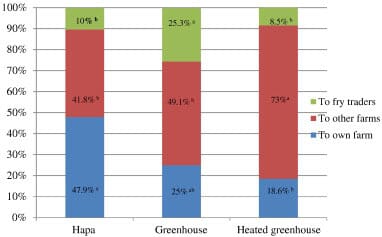
Means in the similar color section with different superscripts are significantly different (P b 0.05).
Fry and fingerling traders purchase seed from hatcheries and sell to farmers. In some cases, the traders simply act as middle men, selling the fish seed directly to farmers while in others the traders stock fry into nursery ponds and grow them for a period sometimes over-wintering them to benefit from strong demand for fingerlings at the start of the next growing season. Escover et al. (1987) reported that in the Philippines, 18 per cent of tilapia seed passed through middlemen while 82 per cent were sold directly to the end user. Nasr-Allah et al. (2012) stated that on average, 56 per cent of tilapia seed production was sold for cash and 44 per cent was sold on credit that took an average of 8 months to be paid off. Yater and Smith (1985) found that private tilapia hatcheries in Laguna and Rizal provinces in the Philippines sold 31 per cent of their production on credit.
Production costs
Table 3 presents information on variable costs (VC) and fixed costs (FC) per million seed produced in the three hatchery systems. On average, 40 per cent of variable costs were allocated to wages including staff salaries (28 per cent) and casual labor (12 per cent) while fish feed was 24 per cent of variable costs. This result is within the range of results reported by Eldokla et al. (2011), and Naiel et al. (2011) who reported that wage costs for tilapia hatcheries were 28.2 per cent and 53 per cent of operational costs, respectively while labor costs represented around 48 per cent of variable costs in a study on hapa-based tilapia hatcheries in Thailand (Bhujel et al., 2001).
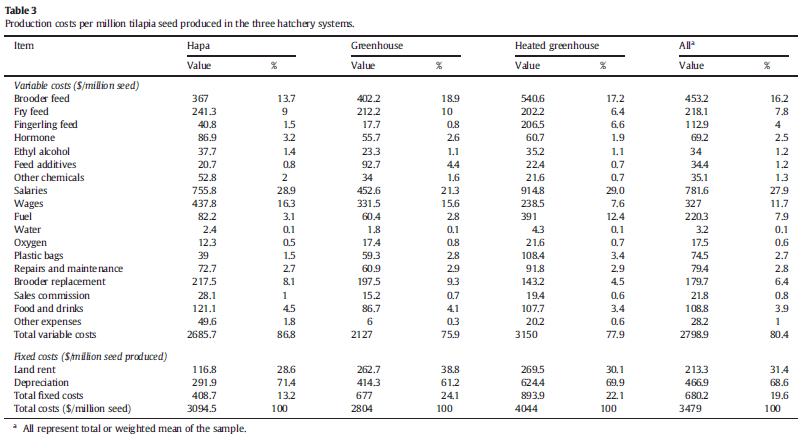
In the current study, the second highest proportion of variable costs (24 per cent) was for fish feed. This is similar to the results reported by Escover et al. (1987) and Bhujel et al. (2001), but lower than the proportion reported by Yater and Smith (1985) and Eldokla et al. (2011) who found feed costs to be 39 per cent and 53 per cent of variable costs in tilapia hatcheries, respectively.
In the current study the cost of 17α-methyltestesterone (MT) hormone was higher in hatcheries operating hapa-based systems compared to the other hatchery systems. Fuel costs per million fry produced were notably higher in heated greenhouse systems (US$ 391, 13 per cent of variable costs) compared to hapa-based (US$ 82, 3 per cent of variable costs) and greenhouse-based (US$ 60, 3 per cent of variable costs) systems.
Average total variable costs per million fry were noticeably lower in greenhouse-based hatcheries (US$ 2127), compared to hapa-based hatcheries (US$ 2685.7). This may be due to higher production levels in greenhouse hatcheries (average 12.17 million fry per year) compared to outdoor, hapa-based hatcheries, which on average produced only 5.82 million fry per year, leading to economies of scale for items such as wages, fuel, water, food and drinks and miscellaneous costs.
Fixed costs averaged 19.6 per cent of total costs but the proportion varied between systems. A similar result was reported by Escover et al. (1987) who found that fixed costs represented 19 per cent of total costs whereas fixed costs represented 29 per cent of total costs in the study by Eldokla et al. (2011) and 32–35 per cent in the study by Bhujel et al. (2001). The highest average fixed costs were for depreciation of equipment and land rent (Table 3). This is similar to the fixed costs reported by Yater and Smith (1985) and Escover et al. (1987). The current study found that fixed costs per unit of fry production were highest in heated greenhouse hatcheries (average US$ 893.9 per million fry produced per year) followed by greenhouse (US$ 677 per million fry per year) and hapa-based hatcheries (US$ 408.7 per million fry per year).
Seed production and sales revenue
Table 4 summarizes the data on sales from the different types of tilapia hatchery, analyzed by sales category: fry, fingerlings and broodstock. The results demonstrate that the main market for tilapia seed in Egypt is for fry (95.6 per cent) rather than fingerlings (4.3 per cent), as fry are much cheaper (US$ 5 per 1000 fry) compared to fingerlings (US$ 20 per 1000 fingerlings) and are easily transported. The most common selling size for tilapia seed is 0.2–0.5 g (just after sex reversal), while fingerlings are sold in the size range from 1 to 5 g after rearing for about 30–45 days in nursery ponds (Nasr-Allah et al., 2012 and Saleh, 2007). Tilapia fry and fingerling prices are relatively cheap compared to other countries, according to benchmarking carried out by Nasr-Allah et al. (2012) who reported that mono-sex tilapia fry of a similar size are sold at US$ 12 per thousand in Thailand and similarly sized fingerlings at US$ 82 per thousand in Kenya.

The study revealed that revenue from fry sales was significantly higher (P < 0.05) in greenhouse and heated greenhouse hatcheries compared to hapa based hatcheries. On average, fry sales represented 85 per cent of sales revenue from the three hatchery systems. Average hatchery revenue was US$ 28,845 per hatchery per year in hapa based systems compared to US$ 62,178 in greenhouse based systems and US$ 74,196 in heated greenhouse systems. In contrast, Naiel et al. (2011) reported that greenhouse based hatcheries generated higher revenue levels than heated greenhouse and hapa based hatcheries.
Financial performance of tilapia hatcheries
The financial performance of the hatcheries is summarized in Table 5. Both variable costs and fixed costs increased significantly (P < 0.05) with increasing levels of technology inputs in the following order: hapa, greenhouse and heated greenhouse. Total cost varied significantly between the three systems (P < 0.05) due to extra costs incurred in upgrading the greenhouse and heated greenhouse hatcheries compared to hapa-based hatcheries. Gross return was significantly higher (P < 0.05) in greenhouse and heated greenhouse systems compared to hapa system. Similarly, income above variable cost was significantly higher (P < 0.05) in greenhouse and heated greenhouse systems compared to hapa-based systems, as both are able to sell some of their production early at the beginning of the growing season, at a time when seed prices are high, to meet farmers' demand to stock their ponds as early as possible.

Average operational profits as percentage of sales were 58.4 per cent, 48 per cent, and 45.8 per cent for greenhouse, heated greenhouse and hapa based systems, respectively, however the differences were not statistically significant (P > 0.05). Against expectation net profit as percentage of sales in heated greenhouse-based system was the lowest at 33 per cent and greenhouse-based system was the highest at 45 per cent of sales. Naiel et al. (2011) reported that tilapia hatcheries generated even higher net profits (70 per cent of sales). They found that the highest net profits were in greenhouse-based hatcheries and the lowest in heated greenhouse hatcheries.
Sensitivity analysis
Sensitivity analysis was performed to measure the financial performance of the three tilapia hatchery systems in the case of increasing operating costs and decreasing seed prices (Table 6). The three factors were identified as critical threats to hatcheries during focus group discussions, particularly the increasing cost of fish feed, fuel and labor costs. The government currently subsidizes diesel fuel prices, which are at present only around US$ 0.20 per liter however it is highly likely that subsidies will be removed or reduced. Also, hatchery operators reported that seed prices have decreased over the years, probably due to increasing competition between hatcheries.
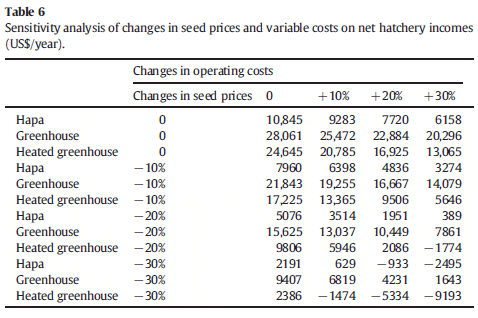
Sensitivity analysis showed that the three hatchery systems would still generate positive net returns even if seed prices decreased by 20 per cent and variable costs increased by 20 per cent. However when seed prices were 30 per cent less than current levels and operating costs were increased by 30 per cent, only the greenhouse-based hatchery system could still generate profits, while the hapa-based and heated greenhouse systems showed losses. Outdoor, hapa-based hatcheries suffer from low productivity but require relatively low levels of investment whereas the additional costs of operating heated greenhouse hatcheries (heating fuel, pumping water, more skilled staff) make them more vulnerable to shocks than simple greenhouse-based systems. However, this does not mean that the future for heated greenhouse hatcheries is bleak. Low energy costs have meant that the usual heating system used in heated greenhouse hatcheries is very inefficient. For example, most make no attempt to recycle water or recover heat from waste water streams so there is considerable scope for improving the technical efficiency of these hatcheries if they had to, and new more efficient hatcheries will be developed in the future. Green et al. (2002) found that a 20 per cent reduction in fish selling prices for Egyptian fish farmers resulted in negative net returns indicating that hatcheries are more tolerant to financial shocks than grow-out fish farms.
Focus group discussions
While the main questionnaire focused on technical and financial performance of the hatcheries, at each location a preliminary focus group discussion was held at which a wider range of issues was raised. The groups were not separated by hatchery type and there was no attempt to quantify the responses.
Many hatcheries complained that fry prices have declined over time, caused by an oversupply from the increasing number of tilapia hatcheries. Oversupply has also led to fry being sold on credit, which means the hatcheries may not get paid for 8 months, with associated cash flow implications. Fry prices also fluctuate through the year peaking at the start of the year (US$ 8–10 per 1000 in early 2012) but decline gradually through the season (US$ 3–4 per 1000 by July/August). Seasonality of seed demand in Thailand was reported by Bhujel (2000), but the authors did not mention if this decline in demand was accompanied by changes in seed price.
Hatchery operators complained of limited water availability and poor water quality particularly between winter and summer seasons for field crops. Similar complaints were reported by Macfadyen et al. (2012) resulting from strict laws over the location of fish farms (only in designated areas) and sources of water that can be used (only from agricultural drainage canals and lakes). This long-standing issue can only be resolved through changes in water use legislation.
Fuel costs and electric power availability were discussed as constraints. Hatcheries that heat their water incur greater costs and many have encountered problems with supply shortages of heating fuel. Heating using electricity is cheaper; however, not all hatcheries have a reliable connection to the electric grid.
Hatchery operators reported difficulties in finding high quality broodstock, particularly female fish, as nearly all Egyptian fish farmers grow all-male tilapia. Hatcheries used to source new tilapia broodstock from the wild, but few undisturbed populations of Oreochromis niloticus remain. WorldFish has developed the Abbassa improved strain of Nile tilapia ( Ibrahim et al., 2012) which is now being disseminated to Egyptian fish farmers under the Swiss-funded IEIDEAS project.
Hatchery owners and managers complained they had to fund developments from their own resources because of difficulties in accessing finance from banks. This was seen as a constraint towards upgrading and modernization of their facilities. Hatcheries and fry/fingerling traders reported difficulties in transporting seed from one governorate to another as police or traffic officers take action against them unless they have a hatchery license and a fry transport permit. Many cannot get the documentation as they are unlicensed. Both these issues could be helped if more hatcheries (and fish farmers) were licensed, a process that could be assisted by better representation through fish farmers' associations.
Hatcheries said there was poor technical support for fish health. The most common problems were death of broodstock and poor fry survival during the rearing stage. The most common fish disease problems were bacterial diseases, fungal diseases and parasitic infections, especially Trichodina and Monogenea.
Some hatchery operators complained that poor quality methyltestosterone hormone can result in low sex reversal rates and fry recruitment in production ponds. Fish farmers may ask for compensation from hatcheries for excessive feed costs and reduced revenue if too many females are discovered at harvest. However, some hatchery managers commented that the problem was due to poor hatchery management rather than hormone quality.
Operators complained that there is a shortage of skilled workers during the breeding season. Hatchery managers have to spend time and effort training unskilled laborers and provide incentives for skilled workers. Meanwhile, hatchery laborers are calling for improvements in their working conditions, such as being covered by national labor laws, pensions and medical health insurance.
Another problem discussed was the small land areas and short-term leases obtained from the regulatory authority and main land-owner, GAFRD, which make it difficult for many hatcheries to invest in or expand their seed production systems (including constructing greenhouses and installing water heating systems) to reduce production costs.
Similar hatchery problems were reported by Yater and Smith (1985) who summarized the major hatchery problems as difficulties in acquiring land, access to capital, sourcing high quality water supplies and the limited number of experienced hatchery technicians. Olaoye and Oke (2012) during their study of hatchery operations in Ogun State, Nigeria, reported similar constraints, as follows; high cost of investment, poor marketing channels, lack of finance, poor genetics of broodstock, lack of skilled staff and unreliable power supplies.
Conclusions
The average production of the 50 tilapia hatcheries covered by this study was 10 million seed per year. Hapa-based hatcheries tended to be smaller and orientated more towards production for the owner's fish farm while greenhouse and heated greenhouse hatcheries were more commercially orientated. All three types of hatchery were very profitable, generating average net profits of 38 per cent of sales.
While heated water hatcheries offer higher production levels, greater flexibility and extended spawning seasons, the extra costs mean that they are no more, and possibly less, profitable than hapa-based or simple greenhouse-based systems. Designs for heated greenhouse tilapia hatchery systems need to be made more efficient in order to improve their sustainability if seed prices continue to decline and costs continue to increase.
May 2014



